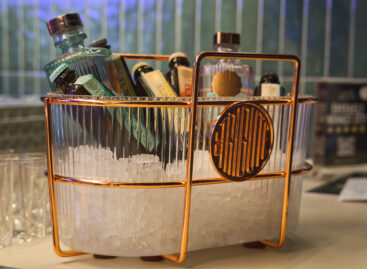Breaking waves
Gin has been a steadily growing category for years, fuelled by consumer trends and the introduction of different flavoured variants.
This article is available for reading in Trade magazin 2024/6-7
Last year was the first that big European trade magazines were writing about the slowdown of the sales growth, which is now confirmed by most Hungarian experts. Gin is entering a phase of consolidation, in part because consumers have started to prefer quality over quantity. People still have the desire to discover new flavours, new experiences that go beyond the classic London Dry. It seems that the future belongs to brands that can offer something new and exciting, without completely abandoning tradition, reinventing gin while preserving its essential identity. Gin has been a very innovative category in recent years, which has provided several opportunities for crossing over into other categories.

The so-called gin-fatigue in Europe’s largest gin markets (UK and Spain) 2-3 years ago is not being seen in travel retail, with duty-free airports and ferries still experiencing strong growth in the sales of the drink
Loves me, loves me not
According to marketing experts, since the end of the pandemic more and more people have been drinking higher quality gin. They aren’t losing their curiosity, but they prefer the timeless classics. There is strong competition in bars and restaurants, and brands have to stand out from the crowd: innovative flavour combinations are important together with quality, and a focus on strong brand identity. Gin – just like vodka and tequila – is versatile, making it possible for bartenders to push the boundaries of drink mixing in different ways. Although gin and tonic remains one of the most popular choices, the qualitative changes are encouraging the consumption of not only so-called sipping gins, but also short cocktails such as the already popular Martini. The popularity of brands (and often their survival) depends very much on changes in consumption habits and the incredible diversity of choice.
The Hungarian market
Sales in the gin category grew at an average annual rate of almost 30% between 2017 and 2022, with growth in the last year going above 40%. The premium segment performed particularly well, with the highest double-digit growth generated by pink and flavoured gins. New brands are entering the market all the time and consumers are increasingly interested in the category.

Dávid Gábor Kovács
marketing director
Zwack
“The gin category grew by approximately 10% in the past year. In 2023 we already saw a slight slowdown in the category’s growth, but it was still the fastest growing compared to other spirits categories”,
informs Dávid Gábor Kovács, marketing director of Zwack.
Zwack distributes three premium gins, Kalumba, Tanqueray and Gordons, with market shares of 19%, 5% and 5%, respectively.
Ginnovation

Attila Piri
marketing director
Heinemann
Attila Piri, marketing director of Heinemann:
“It shows the strength of the gin category that the use of gin menu cards has become widespread in bars and restaurants in recent years! It is primarily the popularity of gin and tonic that is responsible for the category’s strengthening”.
Heinemann distributes Finsbury and Larios gins in the standard category. Japanese gin Roku has produced above average volume sales growth for years. Ophir Gin and the super-premium Scapegrace Gins represent smaller volume sales.

Ádám Kamarás
mixer, brand ambassador
DunaPro
“One of the reasons why the gin category is growing is that unlike whisky, rum and tequila, gin can be made anywhere in the world, as it doesn’t require maturation or specific climatic conditions, and it can be produced using a wide variety of ingredients. It is considerably cheaper and quicker to produce than some other spirits”,
explains Dunapro’s brand ambassador and mixologist Ádám Kamarás.

Péter Bárány
owner
Grand Spirit
DunaPro has Bulldog gin, a member of the Campari portfolio, and two gin-based MIX products: Gin&Mango and Gin&Passionfruit. Péter Bárány, owner of Grand Spirit:
“While the classics still account for the bulk of gin volume sales, modern gins are appealing to new consumers who may have previously chosen a different category of drink, so they have a very important role to play in retaining the category. We produce 4 types of Hungarian gin and the best known of these are Búzavirág and in the premium category Zsolnay, but our Black gin is also becoming popular. In May we launched our collaboration gin Balatonica, which targets the HoReCa channel”.
When will the premiumisation start?

Dr. Csaba Pipei
co-owner
Premirum
Dr Csaba Pipei, co-owner of Premirum:
“My view is that the reason of the growth is that globally many people are turning away from wine and some of them start drinking gin-based long drinks. We are focusing on gins from France, made by the Naud and Deau (Ginetic) cognac companies. The 100 years of distillation experience of Cognac houses is reflected in the fact that they create gins that can be enjoyed in themselves. My view is that the premiumisation process is just starting”.
Zoltán Németh, manager of Mr. Alkohol webshop:
“I think the reason for the expansion of the category is that gin can be used to make a light, refreshing drink that is popular with all age groups – I am talking about gin and tonic. Gin is liked differently than evergreens such as whisky and rum: the latter tend to be consumed neat, while gin is often more suited to cocktails and long drinks. From high-end gins we currently distribute the Akori, Sir Edmond and Parson brands through direct distribution – the first two are available in all trade channels, but Parson can also be found in more and more places; Wave gins are our entry-level category”.
New and newer
Dávid Gábor Kovács told that the biggest challenge in making non-alcoholic gins is maintaining a distinctive herbal profile without using alcohol. Tanqueray 0.0% will be launched in June and is made from high quality herbs, including a unique blend of the four classic Tanqueray ingredients (juniper, coriander, liquorice, angelica root).
Attila Piri opines that tonic adds to and generates the popularity of gin. His personal favourite is Thomas Henry Cherry Blossom Tonic, a blend that harmonises with any of the company’s gins. The traditional RTD market is growing, but the company only has little experience with the new RTDs (also known as ready-to-serve drinks), it will take time for this trend to reach Hungary.
According to Ádám Kamarás, as the selection of premium spirits is expanding, the amount of information and content available about these is growing. Today’s gin lovers are much more informed about current trends and specialities than a few years ago. As for marketing support, in the festive season the modern-looking Bulldog gin is available in a limited edition gift box.
.

The first Hungarian RTD kraft gin and tonic, Zimek Carly’s, is born
What is Hungarian gin like?
Péter Bárány told that they are pleased about the success of Hungarian gins that have won international competitions – these gins are now causing quite a headache for the big brands. The company’s Zsolnay gin has won so many medals in London that they no longer fit on the bottle.
Dr Csaba Pipei informed that they support HoReCa partners with online communication, organising tasting events and launching new products to harness the power of novelty.
Hungarian premium gins such as the artisanal Misi’s gin are up there with the best international products. Tonics and premium sodas are the clear winners of gin’s expansion, says Zoltán Németh. Hungarian gins have their place in the domestic and international gin portfolio, many of them are truly excellent and their international success is well deserved, but he thinks it isn’t a good direction that everyone starts making gin now because it sells relatively fast. //
Gin sales continue to grow
According to the NIQ retail index, gin sales were worth approximately HUF 7bn in April 2023-March 2024. This represents a 20% rise in value sales compared to the previous period and a 7% increase in volume.


Summer purchases accounted for almost a third of gin sales in forint terms, while December generated 14% of sales, up 2 percentage points on the previous year. In the gin category branded products dominated with a 70% value share vs. private label products.
As for sales per litre, private label products were dominant with 45% of the market in the given period. Branded gins were almost twice as expensive on average as private label ones.
Gin was the most popular in the 0.7-litre to 1-litre size range, accounting for more than four-fifths of market sales in forint terms. //
Gin and tonic is more popular than vodka and orange
In the 12-month period from March 2023 to February 2024, gin accounted for 1/20 of the total market for spirits audited by the household panel, both in value and volume.


Guest writer:
Zsombor Ecsedi
analyst
Consumer Panel Services
However, this represents an increase of nearly 50% in value compared to the previous 12-month period and an increase of 28% in volume (a 1 percentage point rise in market share in both cases). Around one in ten Hungarian households are buying gin, a roughly 17% growth compared to last year. Its competitors (mainly spirits used in cocktails: vodka, rum, whiskey) also show a rise in reach, but this doesn’t come with a growth in vodka sales (vodka sales have decreased by 1/10 this year).
One litre of gin costs an average of HUF 7,500 (compared to HUF 8,700 for whiskey, HUF 5,900 for vodka and HUF 6,000 for rum), a HUF 1,000 increase compared to last year. In terms of product size, 700ml purchases account for 85% of sales, but 0.5-litre purchases also occur – but they only have a 10% share in sales, as most of the gin is sold in larger sizes. Households buying gin tend to choose private labels, presumably for economic reasons, as these products represent about 3/5 of gin purchases by volume and only 2/5 of the market by value, due to their value for money nature. These are typically sold by discounters, which is also shown by the fact that these stores realise 60% of gin purchases in volume and 40% in value. //
Gin cocktail trends in 2024
The Diageo Bar Academy website has recently unveiled the key gin cocktail trends for 2024.

Experts say that each bar should have at least one signature gin spritz
Experts recommend bars to benefit from the popularity of spritzers and create at least one signature gin spritz. Both juniper and flavoured gins are suitable for spritzers. Lemon slices enhance the flavour profile, while red berry fruits bring out the fruity notes of pink gins. Spritzer cocktails are the best with prosecco and flavoured sodas. Bars should also offer non-alcoholic cocktails – 0.0% gins are a particularly good for this, especially for long drinks. //
Related news
Premium Gin Hungary introduced the LE Tribute brand at Time Out Market Budapest
🎧 Hallgasd a cikket: Lejátszás Szünet Folytatás Leállítás Nyelv: Auto…
Read more >From hair roots to hair volume
🎧 Hallgasd a cikket: Lejátszás Szünet Folytatás Leállítás Nyelv: Auto…
Read more >Price isn’t enough, promotions and re(in)novation are lifting the plane
🎧 Hallgasd a cikket: Lejátszás Szünet Folytatás Leállítás Nyelv: Auto…
Read more >Related news
KSH: industrial producer prices in November 2025 were on average 2.7 percent lower than a year earlier and 0.3 percent lower than the previous month’s prices
🎧 Hallgasd a cikket: Lejátszás Szünet Folytatás Leállítás Nyelv: Auto…
Read more >Employment at 4.5-year low
🎧 Hallgasd a cikket: Lejátszás Szünet Folytatás Leállítás Nyelv: Auto…
Read more >This is how we eat honey in 2026
🎧 Hallgasd a cikket: Lejátszás Szünet Folytatás Leállítás Nyelv: Auto…
Read more >







